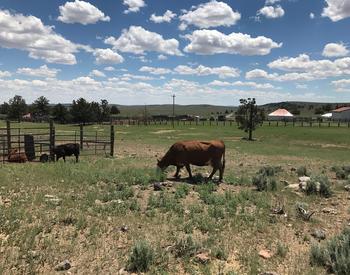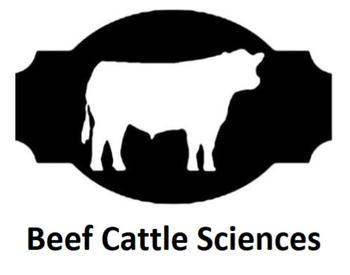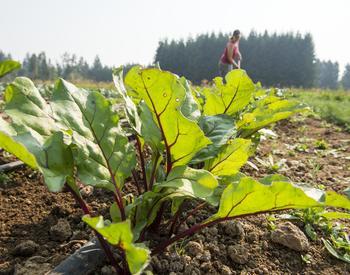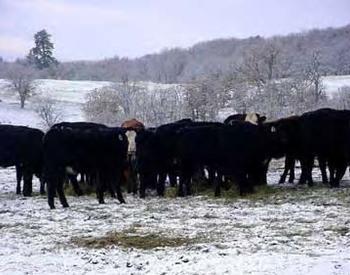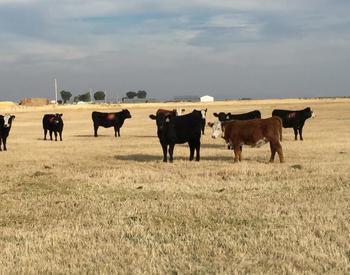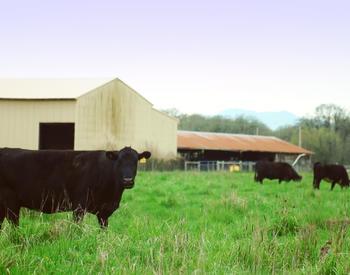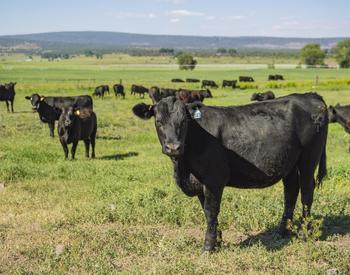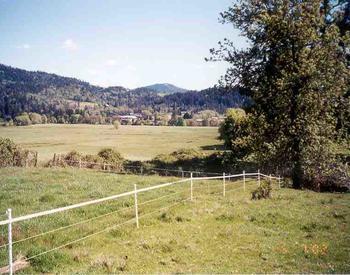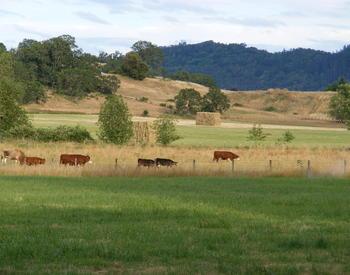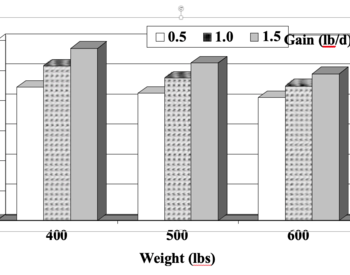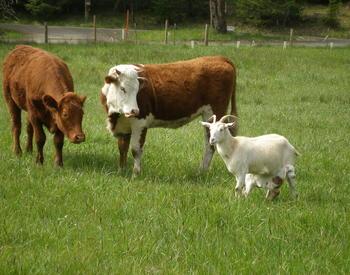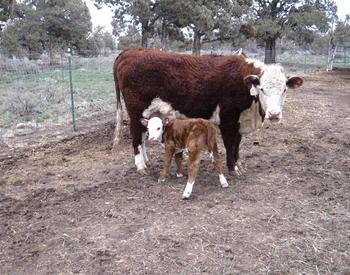Introduction
Nitrate toxicity is a noninfectious and potentially lethal condition whereby cattle consume forages, feedstuffs or water with excessive nitrate concentrations. It is a condition that can affect beef cattle on both sides of the Cascades.
Nitrate toxicity dates back more than 100 years when cattle in Kansas that grazed cornstalk fields late in the fall or early winter died unexpectedly. Since then, the cause of nitrate toxicity in cattle has been broadened to include other factors. Nitrate toxicity is preventable; therefore, it is important that Oregon’s beef producers know the causes and symptoms of nitrate toxicity along with prevention measures to keep their herds healthy and profitable.
Nitrate accumulation
Nitrate accumulation is integral to the plant life cycle. The plant absorbs nitrates from the soil through the roots. Once in the plant, enzymes convert accumulating nitrates to ammonia — using nitrite as an intermediary compound. Finally, ammonia is used to make amino acids and ultimately plant proteins in a process referred to as the nitrate-to-protein cycle. This cycle primarily occurs in growing leaves and requires adequate amounts of water, sunlight and a favorable temperature to convert nitrates to plant proteins.
Several environmental factors can disrupt the normal nitrate-to-protein cycle and lead to an accumulation of nitrates in plants. When nitrate uptake is greater than the rate of nitrate reduction, plants accumulate nitrate. This usually occurs when the plant becomes stressed. Several factors can induce plants to accumulate nitrates. Recognizing these factors allows managers to prevent nitrate toxicity before it becomes costly.
Weather
Extreme temperatures can damage plant tissues and cause nitrate accumulation. In Eastern Oregon, nitrates accumulate in plants that have experienced drought. Soil moisture is needed for plants to absorb nitrate from the soil. During drought conditions, nitrate concentrations are in plants several days after the first rain that restores soil moisture. Temperatures below 55ºF can reduce photosynthetic activity and increase nitrate concentrations. Likewise, frost, hail or extreme weather that damages leaves and reduces plant photosynthesis can cause nitrates to accumulate. In general, nitrates accumulate in the stalks and stems until photosynthesis resumes.
Plant species
Certain plant species are known to accumulate more nitrate compared to others. Crops like corn, oats, canola and wheat can possess excessive nitrate concentrations when harvested prematurely.
Likewise, several weed species are known to accumulate lethal nitrate levels. Examples of such weeds include bindweed, Canada thistle, kochia, lamb’s quarters and nightshade. Sorghum and sudangrass are susceptible to nitrate accumulation, as well as brome and orchard grass to a lesser extent.
Plants commonly associated with nitrate toxicity include:
- Crops
- Alfalfa.
- Barley.
- Canola.
- Corn.
- Fescue.
- Flax.
- Millet oats.
- Orchardgrass.
- Rye.
- Sorghum.
- Soybean.
- Sweetclover.
- Wheat.
- Weeds
- Bindweed.
- Bull thistle.
- Canada thistle.
- Fiddleneck.
- Dock.
- Fireweed.
- Johnson grass.
- Kochia.
- Lamb’s quarters.
- Mustard.
- Nightshade.
- Pigweed.
- Russian thistle.
- Vegetables
- Beets.
- Celery.
- Cucumbers.
- Kale.
- Lettuce.
- Parsnips.
- Radishes.
- Spinach.
- Squash.
- Swiss chard.
- Turnips.
Stage of growth
The stage of growth is a factor to consider when assessing nitrate concentrations. Immature plants generally have higher nitrate concentrations compared to mature plants.
Plant part
Nitrate accumulation is not distributed evenly throughout the plant (Crawford et al. 1961). Accumulation usually occurs in the stalk or in the bottom third of the plant. The middle portion of the stalk has lower concentrations followed by the leaves, the seed/grain and then the flower.
Fertilization
Soil nitrate is the primary nitrate source that accumulates in plants. However, fertilizing a field with N can promote the accumulation of nitrates in plants. Orchardgrass and sudangrass are known to accumulate vast N concentrations after fertilizing that is known to induce nitrate toxicity in cattle (Murphy and Smith 1967).
Shading
There are several scenarios where photosynthesis rates are reduced in plants due to shading. Plants will accumulate nitrates after successive cloudy days. Valleys with limited sunlight are also likely to have plants accumulate nitrates. Other areas where shading could cause increases in nitrates are sites where plant populations are dense.
Herbicides
Herbicides can potentially disturb the nitrate-to-protein cycle and cause nitrate accumulation. An example of one such herbicide is 2,4-D. It can temporarily induce high nitrate levels in plants after application. However, spraying plants with herbicides can also reduce the risk of nitrate toxicity by killing plants high in nitrates.
Disease
Plant diseases can also disrupt photosynthesis leading to potentially lethal nitrate concentrations in cattle. These diseases disrupt the chemical processes that are necessary to convert nitrate to plant protein.
The condition leads to internal suffocation, commonly referred to as anoxia. Animals suffering from the onset of nitrate toxicity may exhibit off-colored mucous membranes, respiratory distress, staggering and/or weakness after extreme weather, successive cloudy days or after fertilizing fields with nitrogen (O’Hara and Fraser 1975). Nitrate toxicity is preventable; therefore, it is important to identify potentially lethal nitrate sources, the symptoms associated with the condition and how to implement strategies to prevent losses to an operation.
Cattle experience nitrate toxicity when nitrite accumulates in the blood. Rumen microbes convert nitrates in cattle feed and water into potentially toxic nitrites. Once produced, it crosses the rumen wall and enters into the circulating blood. In the blood, nitrite disrupts the normal oxygen binding capacity of hemoglobin in red blood cells by oxidizing Fe2+ to Fe3+. The change converts hemoglobin to methemoglobin, a molecule that does not bind oxygen and thereby leads to anoxia. Nitrate toxicity is diagnosed when circulating methemoglobin levels are between 10%–20%, and death occurs when methemoglobin levels near 80% (Kemp et al., 1977).
Cattle can consume lethal nitrate concentrations within hours. Therefore, it is important to recognize nitrate toxicity symptoms to minimize cattle losses.
Symptoms of nitrate toxicity
Cattle may exhibit acute or chronic symptoms in response to nitrate toxicity. Cattle health and production diminishes rapidly after consuming toxic levels of nitrates so it is important to remove cattle from pasture, feed or water sources if these symptoms become evident.
Acute nitrate toxicity can be identified by unique symptoms related to oxygen deprivation as early as three hours after cattle ingest toxic nitrate levels. Animals consuming these levels begin to increase their respiratory rate followed by respiratory distress, muscle tremors and overall weakness. Increased movement produces more severe symptoms and cattle may lie on their side and retain an open mouth. Their mucous membranes are either brown or discolored due to oxygen deprivation. Death typically occurs within 12 hours.
Chronic nitrate toxicity is subtle and potentially devastating. For example, it can decrease reproductive performance and cause dams to abort their calves (Singer 1972). Additionally, nitrites or gases derived from nitrates can destroy carotene and vitamin A and thereby lead to vitamin A deficiency. It can also decrease feed intake and result in weight loss or prevent weight gain. Finally, it can disrupt normal thyroid function by reducing iodine uptake. Additional symptoms associated with chronic nitrate toxicity include a coarse coat and watery eyes.
Levels of nitrate
The nitrate levels consumed by beef cattle determine the extent of nitrate toxicity. These same levels will vary among animals depending on nutritional status, pregnancy status and acclimation to a nitrate-rich diet. For the most part, cattle can safely consume feedstuffs with nitrate levels less than 4,399 ppm nitrate on a dry matter basis (see table below). Forages with nitrate levels between 4,400–9,299 ppm may be safe for nonpregnant animals but can be toxic for pregnant animals. Interestingly, nitrate toxicity can be mitigated by slowly incorporating high nitrate feeds into diets of pregnant animals.
Diets with feeds containing nitrates ranging between 9,300–14,999 ppm are not safe for pregnant animals unless they are diluted to safe levels with feedstuffs without nitrates. In contrast, it is possible for nonpregnant animals to consume these elevated nitrate levels if they are slowly incorporated into the ration. The caveat is that they consist of less than 50% of the total ration on a dry matter basis. Feed sources exceeding 15,000 ppm are not safe for pregnant females. However, they may be incorporated with low nitrate feeds and incorporated at a maximum of 25% of a ration on a dry matter basis.
| Nitrate NO3 (ppm) | Nitrate-Nitrogen NO3N (ppm) | Potassium nitrate KNO3 (ppm) | Recommendations |
|---|---|---|---|
| 0 to 4,399 | 0 to 999 | 0 to 7,038 | Generally safe and nontoxic. |
| 4,400 to 9,299 | 1,000 to 2,099 | 7,040 to 14,878 | Generally safe for nonpregnant animals. Incorporate slowly into the ration of pregnant animals or dilute safe feeds. |
| 9,300 to 14,999 | 2,200 to 3,389 | 14,880 to 23,998 | Incorporate these feeds into a ration slowly. Feed less than 50% of the total ration on a dry matter basis. Not safe for pregnant animals unless diluted with a ration without nitrates. |
| 15,000 or more | 3,390 or more | 24,000 or more | Potentially dangerous so limit to less than 25% of ration on a dry matter basis. Incorporate with low nitrate feed and slowly adapt animals to the mixture. Do not feed to pregnant animals. |
Nitrate in water
Contaminated water can be another source of nitrate toxicity for beef cattle. Due to the soluble nature of nitrate and nitrite in water, cattle can ingest these compounds at higher rates compared to forages and feedstuffs. Therefore, acceptable nitrate and nitrite concentrations in the water are lower compared to those in feedstuffs and forages.
Beef cattle producers should identify the water sources that accumulate nitrates. Nitrate toxicity is likely to occur when cattle consume water from shallow or contaminated sites like ponds, ditches and shallow surface areas that collect the drainage from operations with confined animals on feed. Harmful nitrate levels are less likely to occur from well water sources. Ultimately, do not exceed 200 ppm in water sources because it could induce nitrate toxicity, especially if cattle are also consuming diets high in nitrates.
Interpreting nitrate reports
Nitrate reporting differs among laboratories, which makes it difficult to interpret reports. Some laboratories may report nitrate as a percentage while others report it as either potassium nitrate, nitrogen nitrate or nitrate. To convert a nitrate percentage to ppm, divide the percentage by 10,000. For example, a feed containing 0.04% nitrates on a dry matter basis will have a nitrate equivalent of 400 ppm.
Nitrate conversion factors to compare different reporting methods:
- Potassium nitrate (KNO3):
- = Nitrate x 1.6
- = Nitrate nitrogen x 4.4
- Nitrate:
- = Potassium nitrate x 0.6
- = Nitrate nitrogen x 4.4
- Nitrate nitrogen:
- = Potassium nitrate x 0.14
- = Nitrate x 0.23
Sampling plants or feeds
Feedstuffs and forage crops should be properly sampled if there is any suspicion that nitrate levels may be high. Testing is inexpensive and should be the default procedure to prevent losses from nitrate toxicity. When sampling plants or feeds, it is important to obtain a representative sample of the feed source to get an accurate assessment of nitrate levels.
In order to obtain a representative sample of either silage or green chop, collect samples directly from the mound or pit. In both cases, collect a handful of green chop or silage at least two feet into the feedstuff. Repeat this process and mix the samples from at least six different locations. Next, partition about half a pound of sample into a plastic bag and remove excess air before sealing the bag. Finally, send the bag for laboratory analysis or store it in a freezer until analysis is desired.
Collecting a representative sample of pasture for nitrate analysis is more challenging because the sample should be representative of what cattle will consume. Therefore, collect forage samples by clipping plants in the pasture in question. Estimate what cattle will utilize based on management decisions and clip that amount. Next, clip plants at six different locations within the pasture. Nitrates are concentrated at the base of the plant with lower concentrations in the leaves. So, if the forage utilization is likely to be “light” estimate the upper third of the plant. Thoroughly mix the samples and place half a pound into a plastic bag, remove any excess air and then seal the bag. The bag can be stored in a freezer or sent for analysis.
Proper grazing management is key to avoiding nitrate toxicity when grazing cattle on potentially affected pastures.
Treatment
While death due to acute nitrate toxicity is quick and not commonly realized until deaths occur, there is a potential treatment. If an affected animal is found alive with acute symptoms, contact a veterinarian and ask if an immediate intravenous dose of methylene blue IV would help. Methylene blue IV converts methemoglobin back to hemoglobin and reestablishes oxygen transportation in the blood.
Conclusion
Effectively manage nitrate toxicity by recognizing factors that contribute to the condition and implementing strict prevention measures. Two immediate prevention measures include not letting cattle graze sites where nitrates are suspected and submitting samples to an analytical lab if there is any question about nitrate levels. Additionally, keep the total nitrate concentration in the diet less than 0.5% (5,000 ppm) on a dry matter basis, and do not allow cattle to graze sites that may contain elevated nitrates. Adapt cattle to feeds with high nitrate concentrations by allowing them to slowly consume that feed or forage. The gradual shift in diet will allow the microbe population in the rumen to adjust where nitrates can be readily converted to ammonia.
Furthermore, know where cattle are grazing and never let them on pasture that may have high nitrate levels. Likewise, avoid strip grazing or heavy utilization rates where the stalks of crops or grass stems. Refrain from grazing crops or grasses that are susceptible to nitrate accumulation for a week.
This includes after rainfall, frosts, cloudy days, shaded areas or elevated temperatures that wilt plants. Graze these areas when there is sunlight and do not allow grazing in the evening. Applying these strategies will prevent losses due to nitrate toxicity and promote a healthy herd.
References
Crawford et al. 1961. Agron. J. 53(3):159. Kemp et al. 1977. Neth. J. Agri. Sci. 25:51. Murphy and Smith. 1967. Agron. J. 59:171.
Singer. 1972. In: Proc. of the 76th Ann. Meeting US Anim. Health Assoc. 310.
This document is part of the Oregon State University — Beef Cattle Library. Prior to acceptance, this document was anonymously reviewed by two experts in the area.
